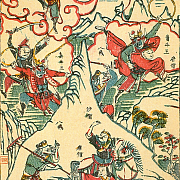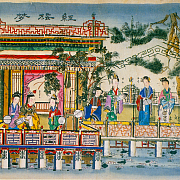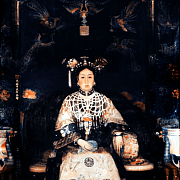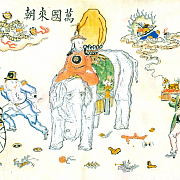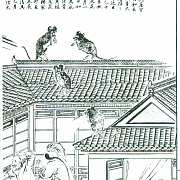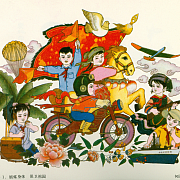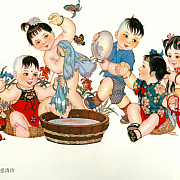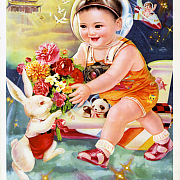First Previous Next Last
Yangliuqing New Year’s Picture:
The Fortunes of a Folk Tradition
Madeleine Yue Dong
Images
Figure 4.1
Many New Years pictures depict aspirations for good fortune through scenes that capture idealized images of prosperity as defined by common familial, moral and social values. Titled “Scene of agricultural work and weaving” (耕織全圖) this print shows men and women in prosperous surroundings as they work diligently at their appropriately gendered tasks. From: Yangliuqing nianhua, Tianjinshi yishu bowuguan ed. (Wenwu chubanshe, Tianjin, 1984).
Figure 4.2
This Kangxi era New Year’s painting titled “A Hall Full of Gold and Jade” expresses aspirations for both wealth and a happy family full of sons and daughters. The Surroundings include fine furniture, embroidered robes, and a glimpse of an elegant garden through the window, depicting an idealized and comfortably wealthy setting. From: Pan Yuanshi and Wang Lixia, Yangliuqing banhua [Yangliuqing Prints]. Taipei: Xiongshi tushu gufen youxian gongsi, 1975.Figure 4.3
This Guangxu era (1871-1908) print captures the exciting climax of the popular Peking opera Chongxiao Lou. Note the play’s name in the top left (the word “Chong” is missing due to damage, but “xiao” and “lou” are clearly visible) and that each character is also labeled by name to aid viewers in identifying the scene. In this highly martial and acrobatic scene, friends band together to victoriously revenge a sworn brother. Thus, the image conveys values of loyalty and brotherhood in an atmosphere or daring-do. From: Yangliuqing nianhua,Figure 4.3b
This late Qing print in a cruder style records a highlight from the popular dramatic saga, the Journey to the West (西游记) often called the Monkey King after the saga’s beloved main character. This picture captures the exciting action as the virtuous Buddhist monk, Xuanzang, is captured by a demon at Jindou Mountain. While many of the prints shown in this chapter are more refined in line and color, the Yangliuqing area produced prints that ranged in quality and price. From: Yangliuqing nianhua,Figure 4.3c
Pictured here are the cast of characters from the novel Dream of the Red Chamber (红楼梦), which, like the Journey to the West, The Romance of the Three Kingdoms, and several other great sagas of Chinese literature, were also tremendously popular subjects for Chinese stage performance. In other words, though Dream of the Red Chamber was a piece of Qing dynasty literature mainly read by the literate higher classes of society, by the late 1800s in many parts of the Qing empire the characters and stories from the novel had entered popular (non-literate) culture by way of the stage. This picture is not from any specific scene in the novel, but rather depicts the story’s main characters (the novel’s famed Nine Beauties and the young man Jia Baoyu, each labeled by name) tidily arrayed in across an idyllic garden landscape. From: Yangliuqing nianhua.Figure 4.4
This court painting of Cixi is in a style quite similar to that of the highest quality Yangliuqing prints. There is no evidence connecting this image to the artist Gao Xuantong, but this is merely one of many portraits of Cixi in a wide variety of styles produced throughout her lifetime. Cixi is a fascinating historical figure in her use of various media for complex and at times playful self-representations. This image, the images below, and several more, are all available through Wikicommons.Figure 4.4b
Cixi’s image crafting extended into publically building relationships with foreign (Western) women. This portrait of Cixi is one of four such oil paintings rendered by the artist Katherine Carl who was invited by Cixi to live at the Qing court while producing paintings of the Empress Dowager for the 1904 St. Louis Exposition. Carl published a popular memoir of her nine-month stay at court in Beijing. From: Wikicommons.Figure 4.4c
Cixi also welcomed the introduction of photography, one of the most modern image producing technologies of her era, into the closely guarded confines of the imperial court, commissioning the staging of several scenes including this one in which she is dressed as the Bodhisattva Guanyin. From: Wikicommons.Figure 4.5
The caption at the top reads “Land mines in Tianjin, victory against the aggressor by Admiral Dong.” This picture celebrates a moment of victory by Qing troops against invading Western and Japanese forces sent to put down the Boxer uprising in 1900. The Japanese forces (note the red sun flag) in the center of the image are attacked from both front and back by Qing troops. From: Yangliuqing nianhua, p. 15.Figure 4.5b
This rather fanciful image of foreign emissaries bearing rare and magical treasure as tribute to the Chinese kingdom gives us an interesting glimpse of the place of foreigners in the popular imagination in the late Qing. The title reads “The ten thousand countries come to (our) court.” From: Wang Shucun ed., Zhongguo minjian nianhua [Chinese folk new years pictures]. Shenzhen: Shandong Meishu chubanshe, 1997.Figure 4.6
This image of Girls at Study is one of many such reform themed paintings from the Republican era. The text is quite explicit about the importance of reforming the “old customs” of gender inequality. From: Yangliuqing nianhua.Figure 4.7
Reformed New Year’s picture depicting the curious new developments in Tangshan. Several Westerners are pictured, identifiable through such details as their dress and facial hair. From: Yangliuqing banhua.Figure 4.8
This and the following figure are from the Dianshizhai huabao or Lithographic Studio Pictorial printed between 1884 and 1898. It is one of the richest resources imaginable to explore visual culture in urban China during this fascinating period. The pictorial was especially focused on introducing current events, ranging from news stories both local and international (like this image of Chinese soldiers rescued at sea by a Western boat) to the astonishing and supernatural (see below). Several online resources are available providing access to hundreds of images from the pictorial. One of best is a website called Virtual Shanghai run, in particular http://www.virtualshanghai.net/Texts/E-Library?ID=1412 and also ID=1411) From: Dianshizhai huabao. Even if you cannot read the Chinese explanations for each image, the range of content is astounding and engaging.Figure 4.8b
Giant rat spirits haunt households that fail to take the proper ritual precautions. From: Dianshizhai huabao.Figure 4.9
Within months of declaring the founding of the PRC, the Chinese Communist Party launched a major art propaganda campaign to revive and reform New Years picture printing nationally. New Years prints conformed wonderfully to the CCP’s propaganda agenda: they were inexpensive, rooted in rural popular peasant culture, bright in color and optimistic in message. Of course there were contradictions too: religious, Confucian and gender-biased themes abounded. Though Yangliuqing’s print industry had gone into steep decline by the 1949 it had not completely vanished, and by the early 1950’s, with government encouragement, production exploded once again. But the content, styles, and messages were remolded to the meet the CCP’s political agenda. This print (“Exercise your body, protect the homeland”) clearly in the “traditional” theme of using young pink-cheeked children (now including girls) to represent aspirations of prosperity, symbolizes that future through modern icons: a motorbike, a parachute, a radio, a plane, a national flag. For an excellent history on the 1950s Nianhua campaign (with a great deal of attention to Yangliuqing but also looking at other locales as well) see Chang-tai Hong’s essay, “Repainting China.” From:Yangliuqing nianhua,Figure 4.9b
Another print from the Mao era, again adapting a theme from an earlier ere, and even formally resembling earlier pictures of 5 young (male babies); the print is title “Babies love cleanliness.”Figure 4.9c
This print from the 1950s titled “Whole-heartedly” again refigures a new image of contemporary prosperity.Figure 4.9d
Yet another refiguring of the “chubby babies” theme, this one from the late 1980s. This print is likely not from Yangliuqing and is one of dozens of such posters to be found in the Stephan Landsberger collection at http://chineseposters.net.Chapter Sample
For more than three hundred years, from the sixteenth century to the early twentieth century, colorful woodblock-printed pictures decorated homes, tea houses, wine shops, and restaurants in towns as well as villages in China during the Spring Festival. These pictures bore different names throughout history, but by the nineteenth century, they were called nianhua, New Year’s pictures. The images reached all levels of society, and they were so important to the families that the word mai (to buy) was often not used in discussing the pictures; instead, this crucial part of the annual celebration was called ying nianhua (welcoming or inviting a New Year’s picture). In his mid-nineteenth century description of “ten things to do for the New Year,” Li Guangting described the custom: After a thorough cleaning of the house, people put up their New Year’s prints on their walls. It was an occasion particularly exciting to children, and it was considered an important part of their education to look at depictions such as “Filial Piety” and “Busy Work in the Field.”
In Li’s words, the pictures “cheered up children, and brightened up the house.”1 (Figure 4.1) But the audience for these pictures was not limited to children; adults enjoyed talking about them just as much. Because the pictures would stay on the walls for the whole year (unless it was necessary to take them down), only to be covered by new ones at the next New Year, they were examined repeatedly and carefully throughout the year. The images were interpreted in detail; every possible reading was tried out; stories were told from the pictures; and knowledge and value were created, conveyed, and confirmed through this process.
Two types of images were used for New Year’s decorations. One type was of gods and goddesses who were believed to protect people from disasters and bring them good fortune (Figure 1.4, see Introduction). These included the god of wealth with his wife and attendants, the stove god and his wife, the earth god, silkworm goddess, granary god, the insect king, god of the well, the ox king, horse guardian, etc., and the powerful door gods.2The other type covered a wide range of themes, such as harvest and seasonal celebrations, daily life activities, scenes from historical stories and dramas, and current events such as wars after the mid-nineteenth century. The term “New Year’s pictures” usually referred to this second type.3The majority of these New Year’s pictures differed from scholars’ paintings in both motifs and colors. They depict narrative stories and figures in bright colors, in contrast to the primary focus on landscape in ink in scholars’ paintings.
New Year’s pictures were deeply rooted in popular cultural beliefs and practices. The artists adopted symbols and codes familiar to the audience to convey the meaning of the pictures; and many of the apparently simple objects in a picture had its special references understandable to the audience. Figure 4.2 from the Kangxi reign (1661–1722), for instance, appears on the surface to be a simple picture of one young woman playing with a girl and two little boys by a fish bowl. The picture carries the title of “A Hall Full of Gold and Jade(金玉滿堂). At first glance, the image seems to be lacking in copious amounts of either gold or jade, though the two children dancing around the fish bowl are wearing beautiful pendants. The reason for the title, however, lies elsewhere. In Northern mandarin dialect, the two characters for goldfish (金魚 jin yu) are homophonous with the characters meaning “gold”(金) and “jade”(玉). One layer of implied meaning of this picture, thus, is wealth: the house will be filled with gold and jade. But there is still another layer of meaning in the picture. “Jin” (gold) was usually used in combination with the word for boy to make the word “jin tong” (金童 golden boy), and “yu” (jade) with girls as in “yu nu” (玉女 jade girl).
Therefore, the picture also expresses a wish for a house full of healthy and happy children. Each little boy, respectively, wears a pendant made of gold or jade on their neck, and the girl’s hair ornament shows a Buddhist symbol for good fortune. New Year’s pictures, in short, expressed people’s wishes for what they considered good fortune and what was important in their lives. By the time of the Qianlong reign (1735–1795), drama scenes had also become popular in New Year’s pictures, and this trend became more apparent and even dominant with the development of Peking Opera in the late nineteenth century (Figure 4.3).The most important locations for the production of New Year’s pictures were Taohuawu in Suzhou in the lower Yangtze region, Mianzhu in Sichuan, Weifang in Shandong, and Yangliuqing near Tianjin. I focus on Yangliuqing in this chapter because among these locations, it enjoyed the longest history in picture making and represented the highest achievement of this folk art form.
The production of New Year’s pictures in Yangliuqing started in the sixteenth century (Ming Dynasty), and reached its peak in the second half of the eighteenth century to the early nineteenth century, when thousands of people were involved in year-round production in this small town and the villages surrounding it. The most productive shops turned out more than one million prints per year that reached a large market in north, northeast, and northwest China.4Yangliuqing’s picture production, however, began to show clear signs of decline in the late nineteenth century, and it almost disappeared by the late 1930s. How did this form of folk art that had enjoyed such a long history nearly disappear within such a short time? Why did its decline and disappearance happen at this historical moment? In order to understand the development and decline of Yangliuqing New Year’s pictures, we need to examine the context of major historical changes: wars, technological developments (railroads, lithography), and economic shifts. The content, quality, and eventually the very existence of these pictures cannot be properly interpreted without understanding the history of the materials used to make them, the labor processes, as well as the distribution and economic networks of the printing business. In this way, Yangliuqing New Year’s pictures are an excellent example for understanding how ways of seeing and looking at images changed over the years, and how comprehending the larger history is crucial to understanding something as small and everyday as a picture on the wall.
1Li Guangting , “Xinnian shi shi” (Ten things to do for the New Year’s celebration) in Xiangyan jieyi (1849) (Beijing: Zhonghua shuju, 1982). Also see Cai Xingwu, “Yanshi huosheng,” in Zhang Jiangcai (ed.), Jing Jin fengtu congshu (Beijing: Zhonghua fengtu xuehui, 1938), 5.
2Po Sung-Nien and David Johnson, Domesticated Deities and Auspicious Emblems: The Iconography of Everyday Life in Village China (Berkeley: Publications of the Chinese Popular Culture Project, 1992).
3Ah Ying, Zhongguo nianhua fazhan shilue (Beijing: Zhaohua meishu chubanshe, 1954), 8–9.
4Gongshang bu, Jingji taolun chu, Jingji banyue kan (Economics bimonthly), vol. 1, no. 3, December 1927, p. 30.
Further Reading
Flath, James A. The cult of happiness: nianhua, art, and history in rural north China. Vancouver: UCB Press, 2004.
Ellen Johnston Laing. Art & Aesthetics in Chinese Popular Prints: Selections from the Muban Foundation Collection. Ann Arbor: University of Michigan Center for China Studies, 2002.
Ellen Johnston Laing. Selling Happiness: A Path to Profits, Passion, and Purpose.
University of Hawaii Press, 2004.
Jason C. Kuo. Visual Culture in Shanghai, 1850s-1930s. New Academia Publishing, LLC, 2007.
Bo Songnian and David Johnson. Domesticated Deities and Auspicious Emblems: The Iconography of Everyday Life in Village China, Popular Prints and Paper Cuts from the Collection of Po Sung-nien.Berkeley: Chinese Popular Culture Project, 1992.
Xiaoqing Ye. The Dianshizhai Pictorial: Shanghai Urban Life, 1884-1898 (Michigan Monographs in Chinese Studies). University of Michigan Press, 2003.
Xiaobing Tang. Origins of the Chinese Avant-Garde: The Modern Woodcut Movement. University of California Press, 2007.
Study Questions
1. Many Yangliuqing New Years pictures, including those used to illustrate this chapter, are packed with details. Look carefully at a picture (or more than one) and note what you observe, including: common everyday objects; signs of elite status or wealth; how women, or boys, or foreigners or famous characters are presented (their dress, hair, coloring etc.); how landscapes and settings are selected and represented, etc. Do you find commonalities from print to print? What might we learn from these details?
2. There are many fascinating connections as wells as contrasts between the New Years pictures from the late Qing and the “reformed” prints of the early 20th century. What similarities do you find? What about notable differences (in content, themes, or styles).
3. This chapter argues that the particular geography of New Years prints (locations where prints were made and marketed) and the specific material processes of their production and distribution (who drew and colored in which parts of the pictures; what kinds of paint were used; how pictures drafted, reproduced, distributed and sold) are crucial elements for understanding this form of visual culture. What might we learn by applying this kind of analysis to other forms of visual culture, both those described in other chapters of this book (1930s photography and films, say; or 1940s and 1950s street demonstrations and political spectacles; or 2010s websites) and to other forms of media in our lives today? What kinds of questions would this lead us to ask about various forms of media and what might we learn historically, economically, and culturally in attempting to answer them?
4. This webpage supplement has touched on many possible topics of late 19th and early 20th century Chinese visual cultural history that merit more exploration. These include: the Empress Dowager Cixi’s engagement with several forms of visual culture during her reign; the rise of lithographic pictorials like Dianshizhai Huabao; the government-led revival of rural folk arts like New Years pictures in the Mao era; and prominence of what in academic-speak might be called visual culture’s inter-textuality—the overlaps between one form of visual culture (for example New Years pictures) with another (for example Peking opera or Chinese drama). Choose one such topic to explore.




